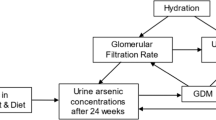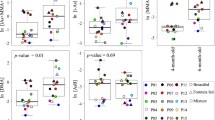Abstract
The amount of arsenic compounds was determined in the liver and brain of pups and in breast milk in the pup's stomach in relation to the route of exposure: transplacental, breast milk, or drinking water. Forty-eight pregnant rats were randomly divided into four groups, each group was given free access to drinking water that contained 0, 10, 50, and 100 mg/L NaAsO2 from gestation day 6 (GD 6) until postnatal day 42 (PND 42). Once pups were weaned, they started to drink the same arsenic-containing water as the dams. Contents of inorganic arsenic (iAs), monomethylarsonic acid (MMA), dimethylarsinic acid (DMA), and trimethylarsenic acid (TMA) in livers and brains of the pups on PND 0, 15, 28, and 42 and breast milk taken from the pup's stomach on PND 0 and 15 were detected using the hydride generation atomic absorption spectroscopy method. Concentrations of iAs, MMA, and DMA in the breast milk, the brain, and the liver of the pups increased with the concentration of arsenic in drinking water on PND 0, 15, 28, and 42. Compared to the liver or brain, breast milk had the lowest arsenic concentrations. There was a significant decrease in the levels of arsenic species on PND 15 compared to PND 0, 28, or 42. It was confirmed that arsenic species can pass through the placental barrier from dams to offspring and across the blood–brain barrier in the pups, and breast milk from dams exposed to arsenic in drinking water contains less arsenic than the liver and brain of pups.





Similar content being viewed by others
References
National Research Council (NRC) (2001) Arsenic in drinking water. Update to the 1999 Arsenic in Drinking Water Report. National Academies, Washington
Focazio MJ, Welch AH, Watkins SA, Helsel DR, Horn MA (2000) A retrospective analysis on the occurrence of arsenic in ground-water resources in the United States and limitations in drinking-water-supply characterizations. Water Resources Investigations Report. U.S. Geological Survey, Reston, pp 99–4279
Habib A, Hayashi T, Sato KK, Hata A, Ikebe M, Rahman F, Hassan P, Endo Y, Endo G (2007) Effectiveness of arsenic mitigation program in Bangladesh—relationship between arsenic concentrations in well water and urine. Osaka City Med J 53:97–103
Sun G (2004) Arsenic contamination and arsenicosis in China. Toxicol Appl Pharmacol 198:268–271
Kurttio P, Pukkala E, Kahelin H, Auvinen A, Pekkanen J (1999) Arsenic concentrations in well water and risk of bladder and kidney cancer in Finland. Environ Health Perspect 107:705–710
Aposhian HV, Zakharyan RA, Avram MD, Sampayo-Reyes A, Wollenberg ML (2004) A review of the enzymology of arsenic metabolism and a new potential role of hydrogen peroxide in the detoxication of the trivalent arsenic species. Toxicol Appl Pharmacol 198:327–335
Goering PL, Aposhian HV, Mass MJ, Cebrian M, Beck BD, Waalkes MP (1999) The enigma of arsenic carcinogenesis: role of metabolism. Toxicol Sci 49:5–14
Kitchin KT (2001) Recent advances in arsenic carcinogenesis: modes of action, animal model systems, and methylated arsenic metabolites. Toxicol Appl Phamacol 172:249–261
Vahter M (2002) Mechanisms of arsenic biotransformation. Toxicology 181–182:211–217
Gebel TW (2002) Arsenic methylation is a process of detoxification through accelerated excretion. Int J Hyg Environ Health 205:505–508
Styblo M, Drobna Z, Jaspers I, Lin S, Thomas DJ (2002) The role of biomethylation in toxicity and carcinogenicity of arsenic: a research update. Environ Health Perspect 110:S767–S771
Liaw J, Marshall G, Yuan Y, Ferreccio C, Steinmaus C, Smith AH (2008) Increased childhood liver cancer mortality and arsenic in drinking water in northern Chile. Cancer Epidemiol Biomarkers Prev 17:1982–1987
Marshall G, Ferreccio C, Yuan Y, Bates MN, Steinmaus C, Selvin S, Liaw J, Smith AH (2007) Fifty-year study of lung and bladder cancer mortality in Chile related to arsenic in drinking water. J Natl Cancer Inst 99:920–928
ATSDR (2000) Agency for Toxic Substances and Disease Registry. Toxicological Profiles for Arsenic USDHHS, Atlanta
National Research Council (NRC) (1999) Arsenic in drinking water. National Academies, Washington
Waalkes MP, Liu J, Diwan BA (2007) Transplacental arsenic carcinogenesis in mice. Toxicol Appl Pharmacol 222:271–280
Chattopadhyay S, Bhaumik S, Nag Chaudhury A, Das Gupta S (2002) Arsenic induced changes in growth development and apoptosis in neonatal and adult brain cells in vivo and in tissue culture. Toxicol Lett 128:73–84
Concha G, Vogler G, Lezcano D, Nermell B, Vahter M (1998) Exposure to inorganic arsenic metabolites during early human development. Toxicol Sci 44:185–190
Jin Y, Xi S, Li X, Lu C, Li G, Xu Y, Qu C, Niu Y, Sun G (2006) Arsenic speciation transported through the placenta from mother mice to their newborn pups. Environ Res 101:349–355
Carter DE, Aposhian HV, Gandolfi AJ (2003) The metabolism of inorganic arsenic oxides, gallium arsenide, and arsine: a toxicochemical review. Toxicol Appl Pharmacol 193:309–334
Aposhian HV (1997) Enzymatic methylation of arsenic species and other new approaches to arsenic toxicity. Annu Rev Pharmacol Toxicol 37:397–419
Wei M, Wanibuchi H, Yamamoto S, Li W, Fukushima S (1999) Urinary bladder carcinogenicity of dimethylarsinic acid in male F344 rats. Carcinogenesis 20:1873–1876
Wei M, Wanibuchi H, Morimura K, Iwai S, Yoshida K, Endo G, Nakae D, Fukushima S (2002) Carcinogenicity of dimethylarsinic acid in male F344 rats and genetic alterations in induced urinary bladder tumors. Carcinogenesis 23:1387–1397
Csanaky I, Gregus Z (2002) Species variations in the biliary and urinary excretion of arsenate, arsenite and their metabolites. Comp Biochem Physiol C 131:355–365
Fischer AB, Buchet JP, Lauwerys RR (1985) Arsenic uptake, cytotoxicity and detoxification studied in mammalian cells in culture. Arch Toxicol 57:168–172
Suzuki KT, Tomita T, Ogra Y, Ohmichi M (2001) Glutathione-conjugated arsenics in the potential hepato-enteric circulation in rats. Chem Res Toxicol 14:1604–1611
Suzuki KT, Tomita T, Ogra Y, Ohmichi M (2003) Arsenic metabolism in hyperbilirubinemic rats: distribution and excretion in relation to transformation. In: Chappell WR, Abernathy CO, Calderon RL (eds) Arsenic exposure and health effects, vol. V. Elsevier, London
Styblo M, Yamauchi H, Thomas DJ (1995) Comparative in vitro methylation of trivalent and pentavalent arsenicals. Toxicol Appl Pharmacol 135:172–178
Hughes MF, Kenyon EM, Edwards BC, Mitchell CT, Razo LM, Thomas DJ (2003) Accumulation and metabolism of arsenic in mice after repeated oral administration of arsenate. Toxicol Appl Pharmacol 191:202–210
Kitchin KT, Del Razo LM, Brown JL, Anderson WL, Kenyon EM (1999) An integrated pharmacokinetic and pharmacodynamic study of arsenite action. 1. Heme oxygenase induction in rats. Teratog Carcinog Mutagen 19:385–402
Hayakawa T, Kobayashi Y, Cui X, Hirano S (2005) A new metabolic pathway of arsenite: arsenic–glutathione complexes are substrates for human arsenic methyltransferase Cyt19. Arch Toxicol 79:183–191
Hughes MF, Kenyon EM (1998) Dose-dependent effects on the disposition of monomethylarsonic acid and dimethylarsinic acid in the mouse after intravenous administration. J Toxicol Environ Health A 53:95–112
Buchet JP, Lauwerys R, Roel H (1981) Urinary excretion of inorganic arsenic and its metabolites after repeated ingestion of sodium metaarsenite by volunteers. Int Arch Occup Environ Health 48:111–118
Buchet JP, Lauwerys R, Roe H (1981) Comparison of the urinary excretion of arsenic metabolites after a single oral dose of sodium arsenite, monomethylarsonate, or dimethylarsinate in man. Int Arch Occup Environ Health 48:71–79
Moore MM, Harrington-Brock K, Doerr CL (1997) Relative genotoxic potency of arsenic and its methylated metabolites. Mutat Res 386:279–290
Ahmad S, Kitchin KT, Cullen WR (2002) Plasmid DNA caused by methylated arsenicals, ascorbic acid and human liver ferritin. Toxicol Lett 133:47–57
Mass MJ, Tennant A, Roop BC, Cullen WR, Styblo M, Thomas DJ, Kligerman AD (2001) Methylated trivalent arsenic species are genotoxic. Chem Res Toxicol 14:355–361
Cohen SM, Arnold LL, Uzvolgyi E, Cano M, St John M, Yamamoto S, Lu X, Le XC (2002) Possible role of dimethylarsinous acid in dimethylarsinic acid-induced urothelial toxicity and regeneration in the rat. Chem Res Toxicol 15:1150–1157
Csanaky I, Nemeti B, Gregus Z (2003) Dose-dependent biotransformation of arsenite in rats—not S-adenosylmethionine depletion impairs arsenic methylation at high dose. Toxicology 183:77–91
Rodriguez VM, Carrizales L, Mendoza MS, Fajardo OR, Giordano M (2002) Effects of sodium arsenite exposure on development and behavior in the rat. Neurotoxicol Teratol 24:743–750
Rodriguez VM, Del Razo LM, Limon-Pacheco JH, Giordano M, Sanchez-Pena LC, Uribe-Querol E, Gutierrez-Ospina G, Gonsebatt ME (2005) Glutathione reductase inhibition and methylated arsenic distribution in Cd1 mice brain and liver. Toxicol Sci 84:157–166
Waters SB, Lin S, Styblo M, Thomas DJ (2003) A novel S-adenosylmethionine-dependent methyltransferase from rat liver cytosol catalyzes the formation of methylated arsenicals. In: Chapell WR, Abernathy CO, Calderon RL, Thomas DJ (eds) Arsenic exposure and health effects, vol. V. Elsevier, New York, pp 255–266
Shiobara Y, Ogra Y, Suzuki KT (2001) Animal species difference in the uptake of dimethylarsinous acid (DMA(III)) by red blood cells. Chem Res Toxicol 14:1446–1452
Lu M, Wang H, Li XF, Arnold LL, Cohen SM, Le XC (2007) Binding of dimethylarsinous acid to cys-13alpha of rat hemoglobin is responsible for the retention of arsenic in rat blood. Chem Res Toxicol 20:27–37
Fangstrom B, Moore S, Nermell B, Kuenstl L, Goessler W, Grander M, Kabir I, Palm B, Arifeen SE, Vahter M (2008) Breast-feeding protects against arsenic exposure in Bangladeshi infants. Environ Health Perspect 116:963–969
Sternowsky HJ, Moser B, Szadkowsky D (2002) Arsenic in breast milk during the first 3 months of lactation. Int J Hyg Environ Health 205:405–409
Acknowledgments
This study was supported by the National Scientific Foundation of China through grant number (NSFC) 30530640 and 30771865.
Author information
Authors and Affiliations
Corresponding author
Additional information
The experimental animals used in this study are approved by the Committee for Animal Research of China Medical University.
Rights and permissions
About this article
Cite this article
Xi, S., Jin, Y., Lv, X. et al. Distribution and Speciation of Arsenic by Transplacental and Early Life Exposure to Inorganic Arsenic in Offspring Rats. Biol Trace Elem Res 134, 84–97 (2010). https://doi.org/10.1007/s12011-009-8455-1
Received:
Accepted:
Published:
Issue Date:
DOI: https://doi.org/10.1007/s12011-009-8455-1




